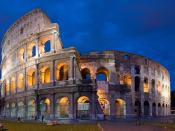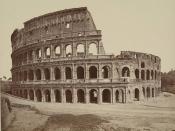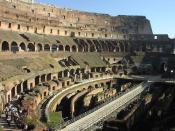Construction of the Coliseum, or Flavian Amphitheater, was begun by Vespasiano c.72 A.D. and inaugurated by his son Titus in 80 A.D. Built on marshy land between the Esquiline and Caelian Hills, it was the first permanent amphitheater to be built in Rome. Its monumental size and grandeur as well as its practical and efficient organization for producing spectacles and controlling the large crowds make it one of the great architectural monuments achieved by the ancient Romans. The Coliseum is a vast ellipse with tiers of seating for 50,000 spectators around a central elliptical arena. Below the wooden arena floor, there is a complex set of rooms and passageways designed for wild beasts and other provisions for staging the spectacles. Eighty walls radiate from the arena and support vaults for passageways, stairways and the tiers of seats. At the outer edge circular arcades link each level as well as stairways between levels.
The three tiers of arcades are faced by three-quarter columns and entablatures, Doric columns in the first story, Ionic columns in the second and Corinthian columns in the third. Above them is an attic story with Corinthian pilasters and small square window openings in alternate bays. At the top brackets and sockets carry the masts from which a canopy for shade was suspended. Small differences in some details of the construction have convinced archaeologists that the building of the Coliseum was entrusted to four different contractors, working side by side in the four quadrants of the amphitheatre. The names of the architects are not known. The idea that thousands of slaves were employed has been rejected, since the quality of the construction is proof of the specialization of the work force. Once completed, the foundation base was covered by a travertine floor, 90 cm thick in average.


